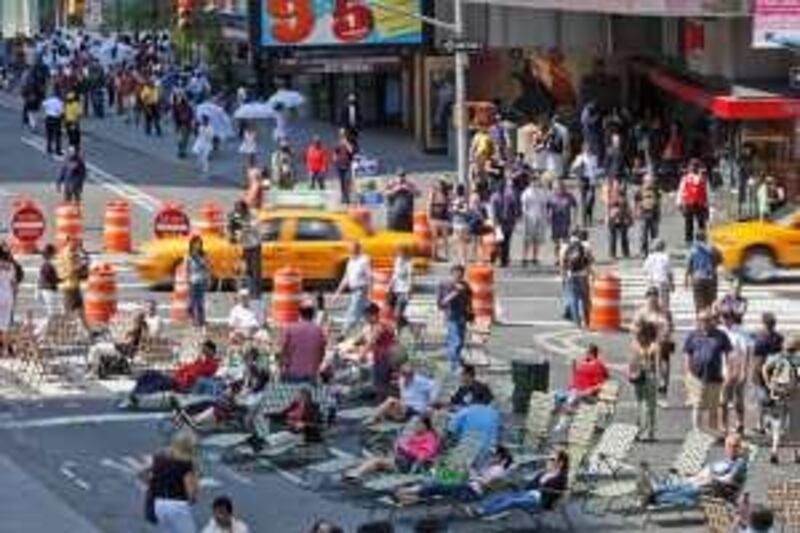NEW YORK // Two German women reclined in their deck chairs one afternoon this week and gazed up at the electronic billboards flashing around them at Times Square. They were sitting in the middle of Broadway where only days earlier, cars, lorries and buses used to roar past and force pedestrians to dodge and weave on the crowded pavements. But thanks to a New York plan to make the city more green and reduce pollution, Sabine Iglauer, 44, and Claudia Nicolaus, 51, spent part of their holiday people-watching in the new car-free pedestrian zone created in what was once one of the most traffic-choked intersections in the Big Apple.
"It's great, gorgeous, impressive," said Ms Iglauer, a manager for the T-Mobile company in Leipzig. "I love it," said Ms Nicolaus, who also works for T-Mobile in Bonn. They were enjoying brief moments of fame as they had already been interviewed by three different international television crews, who recorded the historic transition of Times Square into a pedestrian area this week. A public safety officer walked over. "I hope you ladies are having a wonderful time. Isn't it just beautiful?" he said. "Within a month's time, we're going to have proper tables and chairs out here and it's going to look even better."
Under the urban plan Green Light for Midtown, Broadway was closed to vehicles from 42nd to 47th streets at Times Square, which New Yorkers call the Crossroads of the World. A second promenade was created farther down Broadway between 33rd and 35th streets at Herald Square, home to the massive Macy's department store. Cars are allowed to cut across Broadway at east-west cross streets to reach other north-south avenues. Broadway was originally a pre-colonial footpath, which cuts diagonally across Manhattan's otherwise regular road grid in the Midtown area.
Times Square was a notorious red light and crime-ridden district until it was cleaned up in the early 1990s, but some New Yorkers are nostalgic for the time before the area became synonymous with chain stores and advertisements for big corporations. The recent "greenification" of the area has been pushed by Janette Sadik-Khan, who was appointed the city's transportation commissioner two years ago by Michael Bloomberg, the city's mayor. She said compared to other parts of the city, traffic injuries were 140 per cent higher in Times Square, where 350,000 people walked through each day creating "a human slalom course".
The pedestrian zones are "an important first step to ease traffic and pavement congestion and create safe, attractive spaces that are good for business", said Ms Sadik-Khan. "But it's a work in progress and we'll be monitoring the area closely during the initial adjustment period." The pedestrian zones are to remain as part of a pilot phase until the end of this year but few foresee the city changing its mind and allowing traffic back in, much to the concern of taxi and delivery drivers.
Drivers are also worried that they could end up with fewer streets and parking places after the release of the city's first street design manual last week. The aim is to get development projects to comply with guidelines for all aspects of street architecture, from energy-efficient lamps to more mini-islands with trees and plants to the use of recycled rubber in different colours to cover the pavements.
Many New Yorkers seem to be broadly appreciative of Mr Bloomberg's plans to reduce the city's carbon footprint by 30 per cent by 2030 through measures including improved bus and cycle lanes and the transformation of more streets into green spaces. Michael Sorkin, a renowned architect and often a fierce critic of big developers, welcomed the changes at Broadway. "It's a good start but it doesn't remotely go far enough," he said.
"I would love to see one lane in every street turned over to pedestrians. The city's streets combined are the largest area of public space and they are given to just a single mode of transport - vehicles. But the transportation commissioner does seem to be an enlightened individual and I am persuaded she will increase opportunities for pedestrians and eccentric geographies." A year ago, Ms Sadik-Kahn closed some traffic lanes on Broadway between 42nd Street and Herald Square to create public esplanades. This reduced traffic-related injuries by 50 per cent and smoothed traffic congestion, according to the Department of Transport.
Over the past two years, she has created about 320 kilometres of cycle paths throughout the city. But environmentalists were disappointed at the state legislature's failure last year to introduce congestion charges on drivers. Transport Alternatives, a pressure group for cycling and public transport, released a report last year saying although automobiles carried only 31 per cent of commuters in New York City, they produced 60 per cent of commuting CO2 emissions. The nine per cent who commuted by foot or bike caused zero emissions.
"Chicago, for example, has set a 2015 goal of having residents use bicycles for at least five per cent of all trips less than five miles," the report said. "Clearly, the findings in this report support establishment of comparable goals for New York City." sdevi@thenational.ae






